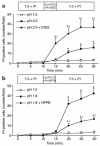Cellular bicarbonate protects rat duodenal mucosa from acid-induced injury
- PMID: 11748264
- PMCID: PMC209463
- DOI: 10.1172/JCI12218
Cellular bicarbonate protects rat duodenal mucosa from acid-induced injury
Abstract
Secretion of bicarbonate from epithelial cells is considered to be the primary mechanism by which the duodenal mucosa is protected from acid-related injury. Against this view is the finding that patients with cystic fibrosis, who have impaired duodenal bicarbonate secretion, are paradoxically protected from developing duodenal ulcers. Therefore, we hypothesized that epithelial cell intracellular pH regulation, rather than secreted extracellular bicarbonate, was the principal means by which duodenal epithelial cells are protected from acidification and injury. Using a novel in vivo microscopic method, we have measured bicarbonate secretion and epithelial cell intracellular pH (pH(i)), and we have followed cell injury in the presence of the anion transport inhibitor DIDS and the Cl(-) channel inhibitor, 5-nitro-2-(3-phenylpropylamino) benzoic acid (NPPB). DIDS and NPPB abolished the increase of duodenal bicarbonate secretion following luminal acid perfusion. DIDS decreased basal pH(i), whereas NPPB increased pH(i); DIDS further decreased pH(i) during acid challenge and abolished the pH(i) overshoot over baseline observed after acid challenge, whereas NPPB attenuated the fall of pH(i) and exaggerated the overshoot. Finally, acid-induced epithelial injury was enhanced by DIDS and decreased by NPPB. The results support the role of intracellular bicarbonate in the protection of duodenal epithelial cells from luminal gastric acid.
Figures







Comment in
-
Choosing sides in the battle against gastric acid.J Clin Invest. 2001 Dec;108(12):1743-4. doi: 10.1172/JCI14652. J Clin Invest. 2001. PMID: 11748256 Free PMC article. No abstract available.
References
-
- Paimela H, Kiviluoto T, Mustonen H, Kivilaakso E. Intracellular pH of isolated Necturus duodenal mucosa exposed to luminal acid. Gastroenterology. 1992;102:862–867. - PubMed
-
- Garner A, Flemström G, Allen A, Heylings JR, McQueen S. Gastric mucosal protective mechanisms: roles of epithelial bicarbonate and mucus secretions. Scand J Gastroenterol Suppl. 1984;101:79–86. - PubMed
-
- Isenberg JI, Selling JA, Hogan DL, Koss MA. Impaired proximal duodenal mucosal bicarbonate secretion in patients with duodenal ulcer. N Engl J Med. 1987;316:374–379. - PubMed
-
- Hogan DL, et al. Duodenal bicarbonate secretion: eradication of Helicobacter pylori and duodenal structure and function in humans. Gastroenterology. 1996;110:705–716. - PubMed

